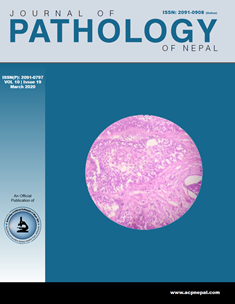Spectrum of hemoglobinopathies in a tertiary care centre
DOI:
https://doi.org/10.3126/jpn.v10i1.27369Keywords:
HbD/HbE hemoglobinopathies, Hemoglobin electrophoresis, Hemoglobinopathies, Sickle cell disorders, ThalassemiaAbstract
Background: Thalassemia and other structural hemoglobinopathies are the most common single gene disorders throughout the world with the highest frequency in the tropics, subtropics, Mediterranean basin and Southeast Asia. This study aims to provide a better assessment on the spectrum of hemoglobinopathies in our context.
Materials and Methods: This descriptive study was done at our tertiary care center, from November 2014 to October 2015. Hematological indices were derived from coulter counter, haemoglobin electrophoresis was carried out by cellulose acetate medium at alkaline PH. Sickling test, Hb H inclusions demonstration and Hb F estimation were performed. Parental screening was done wherever feasible.
Results: Out of 350 cases referred from various out-patient departments of TUTH and different peripheral hospitals for suspected hemoglobinopathies, 97 cases (27.71%) had hemoglobinopathies. The most predominant hemoglobinopathy was thalassemia (57.73%) followed by sickle cell disorders (28.87%) and Hb D/Hb E hemoglobinopathies (13.40%). Most disorders were observed in the age group 21-30 years with many of the cases seen clustered in the families and a slight male preponderance. Terai region (71.13%) had a very high number. A significant high frequency of thalassemia (33.93%) and sickle cell disorders (75%) were seen in Tharu community.
Conclusion: Hemoglobinopathies were seen widespread in Nepal. An extensive screening of the population is important to assess the prevalence of hemoglobinopathies, which will help in identification of carriers and take adequate therapeutic and preventive measures.
Downloads
Downloads
Published
How to Cite
Issue
Section
License
This license enables reusers to distribute, remix, adapt, and build upon the material in any medium or format, so long as attribution is given to the creator. The license allows for commercial use.




